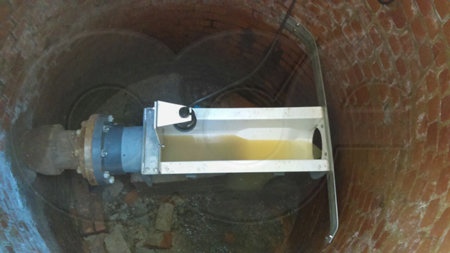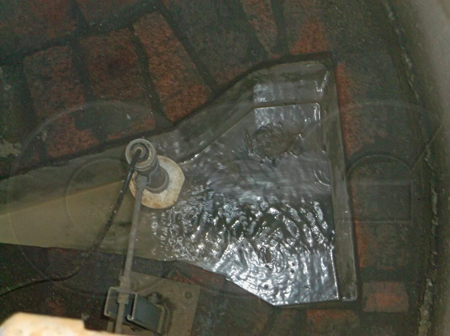This website uses a variety of cookies, which you consent to if you continue to use this site. You can read our Privacy Policy for
details about how these cookies are used, and to grant or withdraw your consent for certain types of cookies.
Monitoring Sewer Flows in Manholes with Flumes
Monitoring the flow of sewage is dirty and smelly, but that doesn’t mean it has to be hard! Many of the problems encountered in measuring surface and / or irrigation waters – high solids content, debris, the need to minimize head loss – are also present in sanitary applications. Over the years a number of different flume styles have been developed for (Palmer Bowlus) or adapted to (Parshall / Trapezoidal / Cutthroat) these flows.
Palmer Bowlus Flumes
The only flume specifically designed for use in sanitary collection systems. The flume was designed for inline installation with existing piping / conduits and has distinct advantages:
- Generally sized to connect to the same size pipe as the flume’s size (i.e. 12” flume for 12” pipe)
- Available in multiple styles for insert, retrofit, and new construction.
- Short length flumes are available for space constrained installations.
- No single point of measurement (useful if obstructions are present).
- Usually self-cleaning at medium to high flows.
- Dimensionless design (other sizes can be developed knowing only the flume width).
Although a good flume, there are some drawbacks to using Palmer Bowlus flumes:
- The flume is not standardized in its design / flow rates. Flumes are proprietary to each manufacturer.
- Requires long (25 pipe diameters) upstream pipe runs.
- Preprogrammed discharge equations may not match specific manufacturer.
- Potential solids collection / sedimentation at low flow rates.
- Low flow applications are usually better served by a different flume type.
- Special flow tables for Insert / Cutback style Palmer Bowlus flumes are not available.
- Above 12” and the flume can be too long to fit into a manhole – although for these and large pipe sizes, the flume can be factory installed in a fiberglass Packaged Metering Manhole.
- Head measurement can be tricky as the height of the throat ramp must be deducted from the usual bottom of flume to top of water reading.

Parshall Flumes
Parshall flumes are well suited to measuring sewage. The flumes offer a number of advantages:
- Flumes with throat widths 3-inches and large do not need to worry about clogging.
- The flume passes solids well.
- It is easy to determine the head / flow rate.
- Should the flume become submerged due to downstream conditions, corrections submergence can be made.
- Should the flume be installed out of level / shift out of alignment, corrections to the flow equation can be made.
- Most operators are familiar with them.
- The Parshall flume can have transitions in / out field grouted (for retrofit installations) or can be provided with inlet / outlet end adapters.
- In drop manhole applications, the flow from the flume can spill off the end
- Preprogrammed into almost every flow meter.
- For flows where a larger / longer flume Is necessary, Parshall flumes can be factory integrated into fiberglass Packaged Metering Manholes.
This is not to say that the Parshall flume isn’t without its drawbacks.
- The base flume is long and with end connections the flume can quickly become longer than what will fit into a standard manhole.
- The floor of the flume drops in elevation as it enters the throat. As a result, the flume may have to sit above the pipe invert – creating standing water upstream.

Trapezoidal Flumes
Originally designed to measure flow in flashy streams, the Trapezoidal flume is an excellent choice for many mixed industrial / sanitary discharge applications.
- Trapezoidal flumes pass solids well.
- Unlikely to clog even on flows with a high sanitary component – the outward opening V means that flow will almost always rise up and over and clog – eventually pushing it through the flume.
- Wide range of operating flows – good low flow resolution while also being able to pass larger flows.
- Flat bottom does not require that the flume be set above the pipe inverts.
- Wide range of styles / sizes available.
- Trapezoidal flumes become wide quickly as flow rates increase and may not fit into an existing manhole.
- Many flow meters are not preprogrammed for the variety of Trapezoidal flume sizes available.
- Flumes become long when end connections are added.

Cutthroat Flumes
A more recent development than the other flumes listed above, Cutthroat flumes have been successfully used in measuring sewage flows.
- Flumes with throat widths 3-inches and large do not need to worry about clogging.
- The flume passes solids well.
- It is easy to determine the head / flow rate.
- Should the flume become submerged due to downstream conditions, corrections submergence can be made.
- Should the flume be installed out of level / shift out of alignment, corrections to the flow equation can be made.
- Most operators are familiar with them.
- The flume can have transitions in / out field grouted (for retrofit installations) or can be provided with inlet / outlet end adapters.
- For flows where a larger / longer flume Is necessary, Cutthroat flumes can be factory integrated into fiberglass Packaged Metering Manholes.
- Intermediate (non-standard) throat width Cutthroat flumes can be developed without the need for laboratory rating.
- There are a multiple classes of flume length / throat width to suit almost any flow rate.
Cutthroat flumes do have drawbacks, though:
- The base flume is long and with end connections the flume can quickly become longer than what will fit into a standard manhole.
- Few flow meters are preprogrammed for the flume.
- The flume can be sensitive to poor upstream conditions.
- Operators can mistake the flume for the similarly shaped Parshall.
Explore more insights in our blog.

LOCATIONS IN ATLANTA, GA & BOISE, ID

